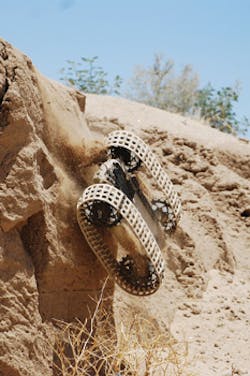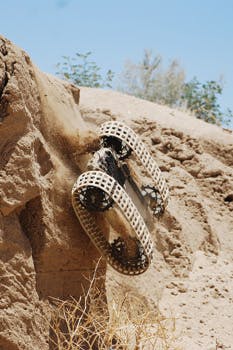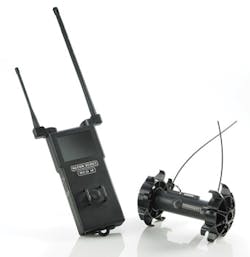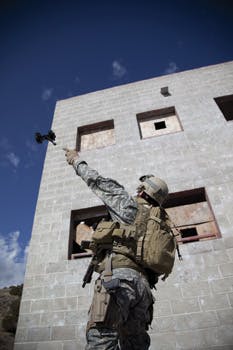Manpackable, throwable robots hit their stride on the battlefield
Use of backpack- and pocket-size robots is taking off among infantry warfighters who need mechanical help to investigate and enter dangerous areas like buildings and other urban terrain.
BY J.R. Wilson
When U.S. forces went into Afghanistan and Iraq after 9/11, their contingent of robots consisted of medium-sized unmanned aerial vehicles (UAVs) and unmanned ground vehicles (UGVs), each ranging from 40 to 500 pounds. At the turn-of-the-century, having a useful capability in a military robot small enough to fit into a single warfighter's backpack was a dream.
But as U.S. ground forces found themselves deeply involved in urban-based counter-insurgency (COIN) warfare in Iraq and the rugged mountains of Afghanistan, that dream quickly became an urgent requirement. Calls for small, lightweight, and capable robots forced industry to fill the bill with rugged commercial off-the-shelf (R-COTS) technologies.
The resulting first generations of robots for individual warriors fell into three categories-micro, mini, and classic manpackables-says Tim Trainer, vice president of international robotic products at iRobot Corp. in Bedford, Mass.
"Many of our customers are interested in our mesh networking capability so robots can communicate within a steel-reinforced building and allow comms links to continue deeper in places where LOS [line of sight] is a challenge," Trainer says. "You can use the FirstLook [iRobot's five-pound throwable, tracked vehicle] as a node to extend the range of other FirstLooks or larger robots."
Using R-COTS is a two-sided proposition. First, it makes the resulting systems immune from International Traffic in Arms Regulations (ITAR), but R-COTS means the underlying technologies are available to anyone, anywhere. That might not be as serious as it sounds, however, says Jack Klobucar, vice president of marketing at small robot maker ReconRobotics in Edina, Minn.
"While our system is COTS, building it in such a way that it is durable, robust, and dependable is a challenge," Klobucar says. "We have been at this for seven years and no one has been able to match us or they already would have significant market share. So it's really our know-how and work with our customers that enable us to add to the capability of our systems."
Each new advance in robotic size, weight, and capability has whetted the military's interest and individual warfighter demand.
"We developed the first hand-launched UAV for information gathering, the Pointer, in 1987, which the U.S. Marine Corps used in a limited basis in Operation Desert Storm," says Steven Gitlin, vice president of marketing strategy at AeroVironment Inc. in Monrovia, Calif. "They were so effective, it drove a resurgent demand for small UAVs through the military and into Congress."
The frontline warfighter carries these types of man-portable UAVs with him to find out what is happening on the other side of a ridgeline or in a building. "Manpack systems can be deployed immediately, day or night, and help determine the critical information needed to turn data into actionable intelligence," Gitlin says.
As each new small UAV and UGV entered service, new and more complex requirements came from the battlespace to industry.
"As the war has progressed, not only have traditional counter-IED [improvised explosive device] customers wanted smaller and lighter robots, so have other dismounted forces," says Charlie Dean, director of unmanned systems business development at QinetiQ North America in Reston, Va.
Robot power
"Component hardware, such as sensors and onboard computing, have gotten smaller and lower power, so you can do more on those small systems," says Jon Salton, engineering project management development at Sandia National Laboratories in Albuquerque, N.M. "Right now we're working primarily on component technologies, our advantage being able to pull from the larger Sandia. We interface a lot with our power research folks, whose solar voltaic research shows real promise for lighter weight, higher reliability, and much greater efficiencies.
"There also is a lot of interesting work being done on batteries, but it is much more in the early research realm for now," Salton continues. "The onset of lithium-ion and other chemistries being combined with lithium are offering the possibility of smaller but more powerful batteries. However, the smaller you go down in platform size, the more limited you are in available power sources. After a while, heat dominates, so there are limits in physics on what you can do with most types, leaving a lot of room for development."
The first lightweight "throwable" robot into Southwest Asia in any number was the Dragon Runner, a 14-pound reconnaissance device for dismounted Marines developed by the National Robotics Engineering Center in Pittsburgh, in collaboration with Automatika in O'Hara Township, Pa., under contract to the Marine Corps during 2002-03. In the next few years, a dozen Dragon Runners were deployed to Marines for sentry and urban reconnaissance. Automatika was acquired by QinetiQ in May 2007.
In the years since then, two Dragon Runner models have evolved. The Dragon Runner 20, with a manipulator arm, raised weight to 20 pounds. It is backpackable, with a wearable controller, and used extensively by the British, Danish, Spanish, and Australian armies. Carried on the back with two harness straps, along with the controller, it has become an important part of those countries' missions in Afghanistan, Dean says.
The Dragon Runner 10, which warfighters carry on their backs, uses the same lightweight controller as the Dragon Runner 20. "In the past couple years, it has become extremely popular with the U.S. Army and Marine Corps, primarily as a reconn platform in Afghanistan, without a manipulator arm," Dean says.
In addition to being ruggedized as a throwable robot, the Dragon Runners can move across uneven terrain using their optional manipulator arms to remotely set them upright should they flip over. Both models can run up and down stairs.
Obstacles from small rocks to stairs, however, can be insurmountable barriers for any UGV much smaller than the DR-10. Nature also presents problems for small UAVs, from trees, rain, and wind. "As they get smaller and smaller, both ground and aerial robots can be quickly overcome by the terrain," Dean says.
Experts from Sandia and the U.S. Defense Advanced Research Projects Agency (DARPA) in Arlington, Va., have looked to a unique design to overcome obstacles by hopping over them. Hopping capability, however, involved a daunting set of requirements, Sandia's Salton says. "So you can drive where you can, hop where you must," he says. "That's where we left it with DARPA, but since then things have advanced to the point we could make it lighter. We also transitioned some of the technology out to industry; Boston Dynamics [bought by Google in December 2013] has a heavier version called the Sand Flea."
First demonstrated publicly in early 2012, the 11-pound Sand Flea can jump more than 30 feet high, with the precision to go through a second- or third-story window, and operate by remote control at distances as far as 215 feet.
"I would say key enabling technologies include the continuing advancement of autonomy, combined with the ability for unmanned systems to work together," says QinetiQ's Dean. "That will be, if not already, the focus on where unmanned systems are going."
Continuing goals
Power, sensors, communications-audio, video, data-mobility through rough terrain or urban canyons, faster and more capable processing, high levels of ruggedization, decreased costs, simplified training and maintenance, small and light enough to be carried in an already over-burdened warfighter's pack-those goals of the past decade of combat will continue into the foreseeable future.
The Pacific pivot places greater demand on the Navy and Marine Corps, and will require robots to be water-tight and saltwater-resistant. Many military robots going to the Pacific will be far larger than manpackable systems-such as the C-Talon, an underwater crawler variant of QinetiQ's top-selling Talon EOD (explosive ordnance disposal) robot. Its mission to locate underwater mines or booby-traps in many ways mirrors the help it provided EOD and counter-IED teams in the Iraqi and Afghan deserts.
"Certainly the Pacific pivot will change the role of unmanned systems, especially due to water obstacles, with a greater use of unmanned maritime vessels," Dean says. "Maritime requirements for environmental protection, especially protection against saltwater spray and immersion, will put some pressure on systems that have operated essentially on dry land."
iRobot's Trainer says he believes small robots will face many of the same requirements in Asia/Pacific as they did in Southwest Asia-but also must be adapted to some significantly different environments. "There will still be IED threats, hostile forces barricaded in buildings and such, so in those cases there won't be a lot of difference," he says.
The real robot challenge of the Pacific pivot will be operating in jungles. "You'll never get a small robot that can operate in a jungle, although one that can be thrown can get some distance for the users," Trainer says. "Small flying robots have some advantages in a jungle environment, but also have heavy foliage and canopy constraints."
In December 2013, the U.S. Department of Defense (DOD) released the Unmanned Systems Integrated Roadmap: Fiscal Years 2013 to 2038 report to assess the future of all unmanned systems and the technology investments required. The report says unmanned systems must provide capabilities more efficiently through modularity and interoperability; be more effective through greater automation and greater performance; be more survivable with improved and resilient communications, development for anti-permissive environments and more security from tampering; and take the 'man' out of unmanned. Personnel costs are the greatest single cost in DOD, and unmanned systems must strive to reduce the number of personnel required to operate and maintain systems, the report says.
"The redistribution of forces will rely more on rapid response, with quickly deployable forces that must be ready to fight battles in a variety of environments. And an even greater dependence on situational awareness, knowing enemy positions and capabilities," predicts Klobucar of ReconRobotics. "Our forces will co-train with indigenous forces wherever they are located, whether in Asia, Africa, or the Middle East, so they can respond together to regional threats. That will create more opportunities for robotics companies because U.S. forces will expose those allies to our technologies and capabilities, opening the door to wider and quicker adoption of those technologies throughout allied forces around the globe."
QinetiQ's Dean also foresees a significant post-OEF/OIF shift in how combat robots are developed, acquired, and controlled-changes that may influence the warfighters using them as greatly as did their introduction into the battlespaces of Southwest Asia.
"The different U.S. military services, in looking at future unmanned systems acquisitions, are seeing the formation of programs of record for many categories of unmanned air and ground platforms, but there have been very few programs of record to date in ground robots," Dean says. "The plan is to increase military use of robots-both types and utility-to help deal with fluctuating personnel numbers and, through PORs, control expenditures.
"So moving through the second half of this decade, the Marines, Army and Air Force are planning many programs of record to carry their robot plans into the 2020s," Dean continues. "Those will be very tightly controlled-the cost of robots will go down, for example, with the government better able to control what they pay than when they were buying essentially COTS products during this war."
Programs of record also are required to assure funding; during the Second Gulf War, many systems were rapidly acquired and immediately fielded using the Joint Urgent Operational Needs process. JUONs were funded largely through overseas contingency operations (OCO) funding, a source no longer available with the U.S. drawdown.
The second major change may negate-or at least postpone-the need for every warfighter to carry some type of robot in his or her kit, while simultaneously improving combat coordination of robotic assets-air, land, and sea.
Universal controllers
"The Marines want to simplify training, logistics, acquisitions, so through considerable experimentation and working with other companies the Corps has brought in, QinetiQ developed the Tactical Robotic Controller [TRC], which the Navy and Marines already have used to control more than 20 different types of unmanned systems using software the UAV/UGV manufacturers loaded into TRCs provided by the Corps," Dean says.
One of the keys was simplicity. Dean reported one company inte- grated their aircraft into a TRC in a tradeshow booth in 20 minutes, while four or five UGV companies have integrated their robots into the universal controller, as well.
The need arose when the Marines discovered they often had combat units employing a range of small robots, built by different companies and requiring the use of unique controllers, thus increasing the load warfighters had to carry into the field, as well as training, maintenance, and logistics requirements. For typically small field units such as used by the Corps, that often meant the same Marine had to be trained in and operate three or four controllers on a single mission.
The Navy and Marine Corps put out a bid to industry to develop a wearable common controller weighing less than eight pounds that could handle all Corps UGVs, Class 1 UAVs, and unattended ground sensors.
"Little, medium, and big robots tend to have different controllers, but the Marines were getting increasingly concerned about the multiple controllers, batteries, etc., they were seeing. We won that competition about three years ago and have been steadily developing that type of controller, although getting it down to eight pounds took a lot of hard engineering," Dean says. "Other typical controllers able to handle this kind of variety may weigh up to 30 pounds for just one type of robot. Most were too awkward for dismounted ops. And if a company had been using a laptop-based controller, it frequently had commercial batteries that were hard to recharge in the field. Even worse, it is not unusual with even small UAVs to have two different controllers to fly just one UAV."
The biggest challenge in controlling several unmanned vehicles simultaneously is twofold-first, the software operating system such as Windows or Linux, and second, the type of radio interface. The latter is the larger of those because there is no common radio across unmanned air and ground systems, although the military has requested development of one or more families of common radios for air-to-air, air-to-ground, ground-to-ground, etc.
"We have shown we can drive two robots at the same time, although we believe we can do more than two. And the Army, which has become very involved in the TRC, has shown they can fly a Class One UAV at the same time the operator can drive a ground robot," Dean says. "When doing two simultaneously, you are giving command and control instructions to one while monitoring the other platform, then switch. So you're basically juggling the C2 functions. But eventually we will be able to give independent C2 instructions at the same time. The TRC is a small tablet with a cable running to the console and can have one or two touchscreens. When doing ground and air simultaneously, the dual-screen TRC has become very popular and useful because you can segregate the information you're getting on those two screens. You also can use a monocular device, so you're not limited on that score and can use your own imagination, depending on display and input requirements."
Although developed to meet a Marine Corps requirement, the Army has taken the TRC into combat in the largest quantities to date, using them in Afghanistan since the Fall of 2011.
While a manpackable, lightweight device such as the TRC would give one warfighter the ability to control multiple robots, Dean and some others believe every warfighter will be able to access everything coming from every robot in the area, perhaps even using a smartphone app. If so, such a multifunctional device could make it unnecessary to provide each with a personal manpackable robot, as well.
Evolving technologies are also giving some or all those robots varying degrees of autonomy, reducing the need for warfighters to handle robot operations instead of pursuing more direct missions against an enemy.
"Autonomy definitely will become a more prevalent part of robotic technologies in the years to come, but that is a major step from where we are today. It is very hard to put even semi-autonomy on ground systems that are accurate enough to meet user needs while keeping the price down. At this point, we're just beginning to add semi-autonomy on field-ready systems," Dean says. "But as commercial industry, especially automotive, moves forward, they will play a big role in bringing down the size and cost of the sensors required. The military will benefit greatly from those. As to full autonomy and the software required to make decisions, those should come together with less expensive systems in about 10 years. That means the onboard computer can work with those to start to make its own decisions and aid the warfighter."
Smaller, more capable manpackable robots can significantly improve individual warfighter and small unit capabilities, but still face a barrier stretching back to the Roman Legions-the amount of weight a warrior must carry into battle-versus warfighter demand. After their experiences in Southwest Asia, Trainer notes, no EOD team will go out without some form of robot-and the rest of the nation's ground troops are quickly adopting the same attitude.
"The benefits of robotics are well known and infantry troops are pulling for that capability, but not at the expense of the load on their backs. So how do you balance robots against UAVs, weapons, supplies, and everything else they have to carry? That may be a high-low mix, with individual warfighters having something like FirstLook, then the squad having a larger, more capable robot," Trainer says. "There are always tradeoffs. How do you work that into your combat logistics and what is acceptable in a combat situation? I think robotics will be an integral part of the infantry going forward, but we really haven't defined what that will look like. Much of it will require more experimentation, but lessening the load will always be considered critical."
There also is a non-technical development in the increased use of "personal" robotics by warfighters and the interaction between them, what the Roadmap calls part of the Marine Corps' Middle-Term Future State (2017-2022)-"enhanced human-robot interaction that enables teaming and trust."
University of Washington researcher Dr. Julie Carpenter interviewed numerous EOD personnel and found warfighters in combat and first responders at home were developing an almost anthropomorphic relationship with their robots-something that might become even more prevalent as more and more warfighters carry personal robots in their packs. Carpenter's research led to what she identifies as Robot Accommodation Dilemma and attachments that she believes are continuing to evolve as robotic technology advances.
"Simply put, RAD describes how the people I spoke with described a challenge of conflicting emotions, expectations and experiences when interacting with EOD robots and how they struggle to fix the identified problems in order to succeed. They were very clear it was a tool, but at the same time, patterns in their responses indicated they sometimes interacted with the robots in ways similar to a human or pet," Carpenter wrote. "The act of attachment and its related concepts of bonding, cohesion and trust may impact operator decision-making. Some operators also described robots as an extension of themselves, literally or figuratively. You don't want someone to hesitate using one of these robots if they have feelings toward the robot that goes beyond a tool. If you feel emotionally attached to something, it will affect your decision-making."
Coming off a decade of combat in which personal robots became increasingly vital to the success and safety of U.S. warfighters and into one in which the methods of development and acquisition will change radically as budgets continue to decline, the future is both technologically bright and programmatically murky.
"The ability for every individual warfighter to be able to extend beyond themselves using manpack- able robotics technology would be a critical component of how capable the force as a whole will be. But what form it takes is anybody's guess, probably varying according to the specific needs of each soldier," Salton concludes. "But I think we also will transform emergency response in the next couple of decades, with better comms, situational awareness, status of responders, locating victims, etc. Having a combination of manned and unmanned systems working together will be critical to providing a more rapid response with integrated capabilities between people and machines."




